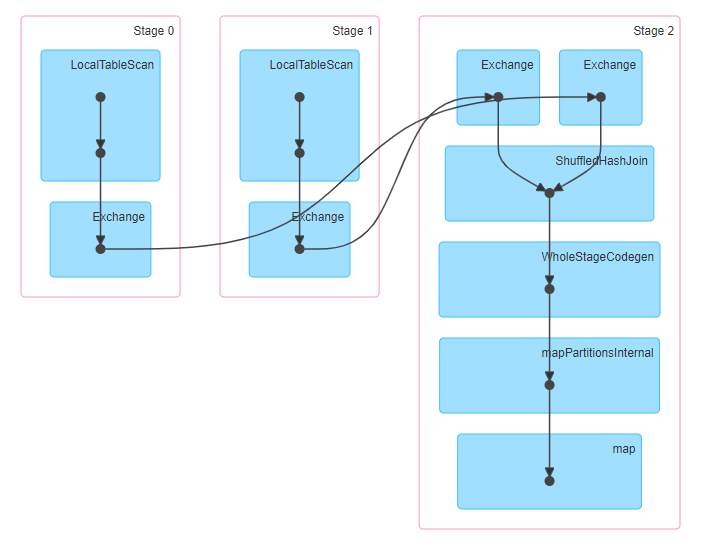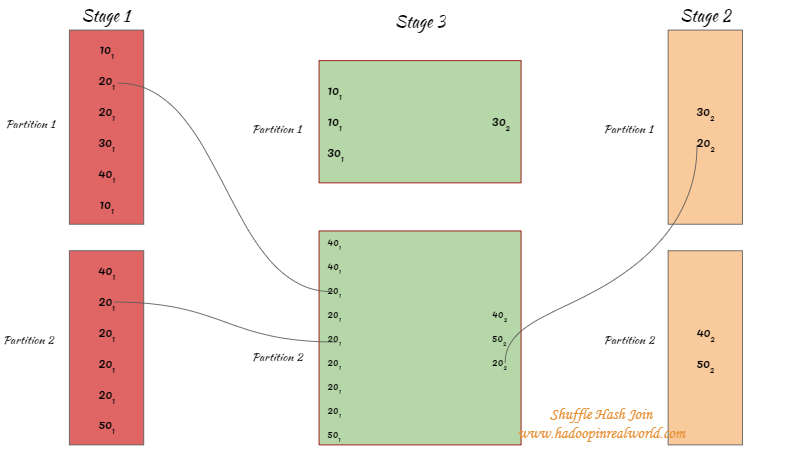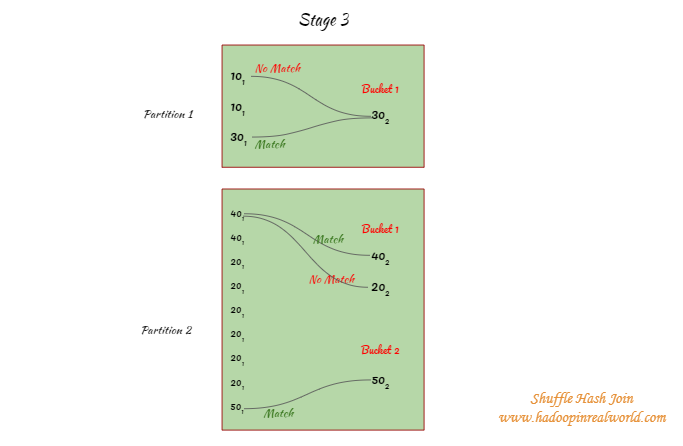How to delete a Kakfa topic?
December 30, 2020How to convert a String to Integer in Hive?
January 4, 2021Shuffle Hash Join, as the name indicates works by shuffling both datasets. So the same keys from both sides end up in the same partition or task. Once the data is shuffled, the smallest of the two will be hashed into buckets and a hash join is performed within the partition.
Shuffle Hash Join is different from Broadcast Hash Join because the entire dataset is not broadcasted instead both datasets are shuffled and then the smallest side data is hashed and bucketed and hash joined with the bigger side in all the partitions.
Do you like us to send you a 47 page Definitive guide on Spark join algorithms? ===>
Shuffle Hash Join is divided into 2 phases.
Shuffle phase – both datasets are shuffled
Hash Join phase – smaller side data is hashed and bucketed and hash joined with he bigger side in all the partitions.
Sorting is not needed with Shuffle Hash Joins inside the partitions.
Example
spark.sql.join.preferSortMergeJoin should be set to false and spark.sql.autoBroadcastJoinThreshold should be set to lower value so Spark can choose to use Shuffle Hash Join over Sort Merge Join.
scala> spark.conf.set("spark.sql.autoBroadcastJoinThreshold", 2)
scala> spark.conf.set("spark.sql.join.preferSortMergeJoin", "false")
scala> spark.conf.get("spark.sql.join.preferSortMergeJoin")
res2: String = false
scala> spark.conf.get("spark.sql.autoBroadcastJoinThreshold")
res3: String = 2
scala> val data1 = Seq(10, 20, 20, 30, 40, 10, 40, 20, 20, 20, 20, 50)
data1: Seq[Int] = List(10, 20, 20, 30, 40, 10, 40, 20, 20, 20, 20, 50)
scala> val df1 = data1.toDF("id1")
df1: org.apache.spark.sql.DataFrame = [id1: int]
scala> val data2 = Seq(30, 20, 40, 50)
data2: Seq[Int] = List(30, 20, 40, 50)
scala> val df2 = data2.toDF("id2")
df2: org.apache.spark.sql.DataFrame = [id2: int]
scala> val dfJoined = df1.join(df2, $"id1" === $"id2")
dfJoined: org.apache.spark.sql.DataFrame = [id1: int, id2: int]
When we see the plan that will be executed, we can see that ShuffledHashJoin is used.
scala> dfJoined.queryExecution.executedPlan res4: org.apache.spark.sql.execution.SparkPlan = ShuffledHashJoin [id1#3], [id2#8], Inner, BuildRight :- Exchange hashpartitioning(id1#3, 200) : +- LocalTableScan [id1#3] +- Exchange hashpartitioning(id2#8, 200) +- LocalTableScan [id2#8] scala> dfJoined.show +---+---+ |id1|id2| +---+---+ | 20| 20| | 20| 20| | 40| 40| | 40| 40| | 20| 20| | 20| 20| | 20| 20| | 20| 20| | 50| 50| | 30| 30| +---+---+
Stages involved in Shuffle Hash Join
As we can see below a shuffle is needed with Shuffle Hash Join. First dataset is read in Stage 0 and the second dataset is read in Stage 1. Stage 2 below represents the shuffle.

Internal workings for Shuffle Hash Join
There are 2 phases in a Shuffle Hash Join – Shuffle phase and Hash Join phase.
Shuffle phase
Data from both datasets are read and shuffled. After the shuffle operation, records with the same keys from both datasets will end up in the same partition after the shuffle. Note that the entire dataset is not broadcasted with this join. This means the dataset in each partition will be in a manageable size after the shuffle.

Hash Join
- After the shuffle, Spark picks one side based on the statistics and will hash the side by key in to buckets
- In the below example, we have 2 partitions and side 2 is picket for hashing and will be assigned to buckets. There is one bucket in partition 1 with key 20. Partition 2 has 2 buckets 20 and 40 are assigned to bucket 1 and 50 assigned to bucket 2.
- Keys from the big dataset will be attempted to match ONLY with the respective buckets. For eg. in partition 1 when the hash value of 101 results in anything other than bucket 1 a match will not be attempted. In partition 2, 401 will only be attempted to match with keys in bucket 1 and not with bucket 1 because 401 is hashed to bucket 2.
- Hash join is performed across all partitions after the shuffle.
Sorting is not needed for Shuffle Hash Joins.

When does Shuffle Hash Join work?
- Faster than a sort merge join since sorting is not involved.
- Works only for equi joins
- Works for all join types
- Works well when a dataset can not be broadcasted but one side of partitioned data after shuffling will be small enough for hash join.
When Shuffle Hash Join doesn’t work?
- Does not works for non-equi joins
- Does not work with data which are heavily skewed. Let’s say we are joining a sales dataset on the product key. It is possible that the dataset has a disproportionate number of records for a certain product key. Shuffle will result in sending all the records for this product key to a single partition. Hashing all the records for this product key inside a single partition will result in an Out of Memory exception. So Shuffle Hash Join will work for a balanced dataset but not for skewed dataset.


2 Comments
[…] Interested in learning about Shuffle Hash join in Spark? – Click here. […]
[…] How does Shuffle Hash Join work in Spark? […]